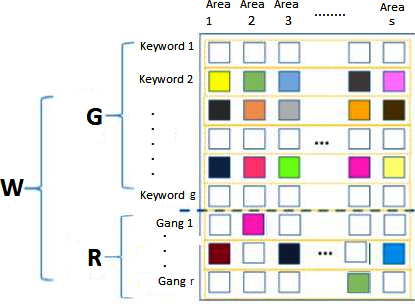 Gang-related homicides account for a significant proportion of criminal activity across the world, especially in countries of Latin America. They often arise from territorial fights and, distinct from other types of homicides, are characterized by area-specific risk indicators. Current crime modeling and prediction research has largely ignored gang-related homicides owing to: (i) latent dependencies between gangs and spatial areas, (ii) area-specific crime patterns, and (iii) insufficiency of spatially fine-grained predictive signals. To address these challenges, we propose a novel context-aware multi-task multi-level learning framework to jointly learn area-specific crime prediction models and the potential operating territories of gangs. Specifically, to sufficiently learn the finer-grained area-specific tasks, the abundant knowledge from coarse-grained tasks is exploited through multi-task learning. Experimental results using online news articles from Bogot´a, Colombia demonstrate the effectiveness of our proposed method.
Gang-related homicides account for a significant proportion of criminal activity across the world, especially in countries of Latin America. They often arise from territorial fights and, distinct from other types of homicides, are characterized by area-specific risk indicators. Current crime modeling and prediction research has largely ignored gang-related homicides owing to: (i) latent dependencies between gangs and spatial areas, (ii) area-specific crime patterns, and (iii) insufficiency of spatially fine-grained predictive signals. To address these challenges, we propose a novel context-aware multi-task multi-level learning framework to jointly learn area-specific crime prediction models and the potential operating territories of gangs. Specifically, to sufficiently learn the finer-grained area-specific tasks, the abundant knowledge from coarse-grained tasks is exploited through multi-task learning. Experimental results using online news articles from Bogot´a, Colombia demonstrate the effectiveness of our proposed method. Forecasting Gang Homicides with Multi-level Multi-task Learning
- Conference Paper
 Gang-related homicides account for a significant proportion of criminal activity across the world, especially in countries of Latin America. They often arise from territorial fights and, distinct from other types of homicides, are characterized by area-specific risk indicators. Current crime modeling and prediction research has largely ignored gang-related homicides owing to: (i) latent dependencies between gangs and spatial areas, (ii) area-specific crime patterns, and (iii) insufficiency of spatially fine-grained predictive signals. To address these challenges, we propose a novel context-aware multi-task multi-level learning framework to jointly learn area-specific crime prediction models and the potential operating territories of gangs. Specifically, to sufficiently learn the finer-grained area-specific tasks, the abundant knowledge from coarse-grained tasks is exploited through multi-task learning. Experimental results using online news articles from Bogot´a, Colombia demonstrate the effectiveness of our proposed method.
Gang-related homicides account for a significant proportion of criminal activity across the world, especially in countries of Latin America. They often arise from territorial fights and, distinct from other types of homicides, are characterized by area-specific risk indicators. Current crime modeling and prediction research has largely ignored gang-related homicides owing to: (i) latent dependencies between gangs and spatial areas, (ii) area-specific crime patterns, and (iii) insufficiency of spatially fine-grained predictive signals. To address these challenges, we propose a novel context-aware multi-task multi-level learning framework to jointly learn area-specific crime prediction models and the potential operating territories of gangs. Specifically, to sufficiently learn the finer-grained area-specific tasks, the abundant knowledge from coarse-grained tasks is exploited through multi-task learning. Experimental results using online news articles from Bogot´a, Colombia demonstrate the effectiveness of our proposed method. 